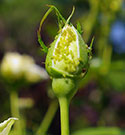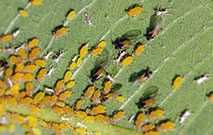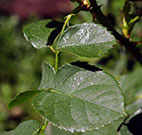home | spring garden | rose garden
Aphid
There are 1,375 species of aphids in Canada and the United States combined. Depending on species, these insects can be green, yellow, or black. They have pear-shaped soft bodies that measure no bigger than an eighth of an inch. These insects are typically flightless and do not have wings, but can form wings, depending on the environment. Two factors make aphids stand out from the rest of the insect world, one being that they often do not lay eggs but give live birth to their young, and another being that many are females that produce without mating. Reproduction is rapid. Females can produce up to 100 daughters during their lifespan. Each daughter reaches reproductive maturity after about eight days. Populations are largest during the spring season when there are few predators and a lot of fresh growth for food. These tiny insects have piercing-sucking mouthparts that penetrate stem, leaf, and flower tissue to drain the nutrients from the veins. Although this practice can be harmful to plants, the more threatening aspect of an aphid infestation is their ability to spread diseases quickly. Aphids excrete a substance we call honeydew. This is a sugary liquid made from unused plant sap and waste. Honeydew is a great medium for sooty mold, an unsightly fungus. In a rose garden, the most common aphid will likely be the rose aphid, which feeds on rose buds and stems.
 |
 |
 |
 |
